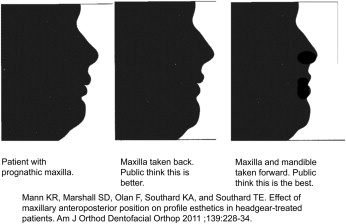Since the days of Edward Angle, many clinicians have accepted that Class II malocclusion is the consequence of a protruded maxilla and a retruded mandible; the late Bob Moyers was the first clinician I heard to suggest that some Class II maxillas might be correctly positioned. We have known since the 1970s that good-looking faces are prognathic and vice versa. This becomes more obvious if their profiles are superimposed on the cranial vault, showing that a forwardly placed maxilla has both esthetic and dental advantages.
Many universities have now stopped using retractive Ibebet headgear, and I was surprised therefore to see the article recommending its use (Mann KR, Marshall SD, Qian F, Southard KA, Southard TE. Effect of maxillary anteroposterior position on profile esthetics in headgear-treated patients. Am J Orthod Dentofacial Orthop 2011;139:228-34). I understand their logic, but personally I think it is founded on the wrong premise. They assumed that an FH:NA >92° indicates maxillary prognathism, presumably based on the beliefs of Steiner and his supporters. In my view, this concept defines “straight faces” rather than attractive ones.
In their article was an illustration of a “protrusive” maxilla and the “improvement” achieved by retracting it, confirming that the public prefers a balanced maxilla and mandible. However, their panel of 20 laypersons was not given the option of viewing patients when both the maxilla and the mandible had been moved forward. We took the liberty of adjusting the silhouette to demonstrate this ( Fig ). A random test showed that this profile was overwhelmingly preferred by the public, suggesting a need to consider methods that can convert vertical growth to horizontal.





